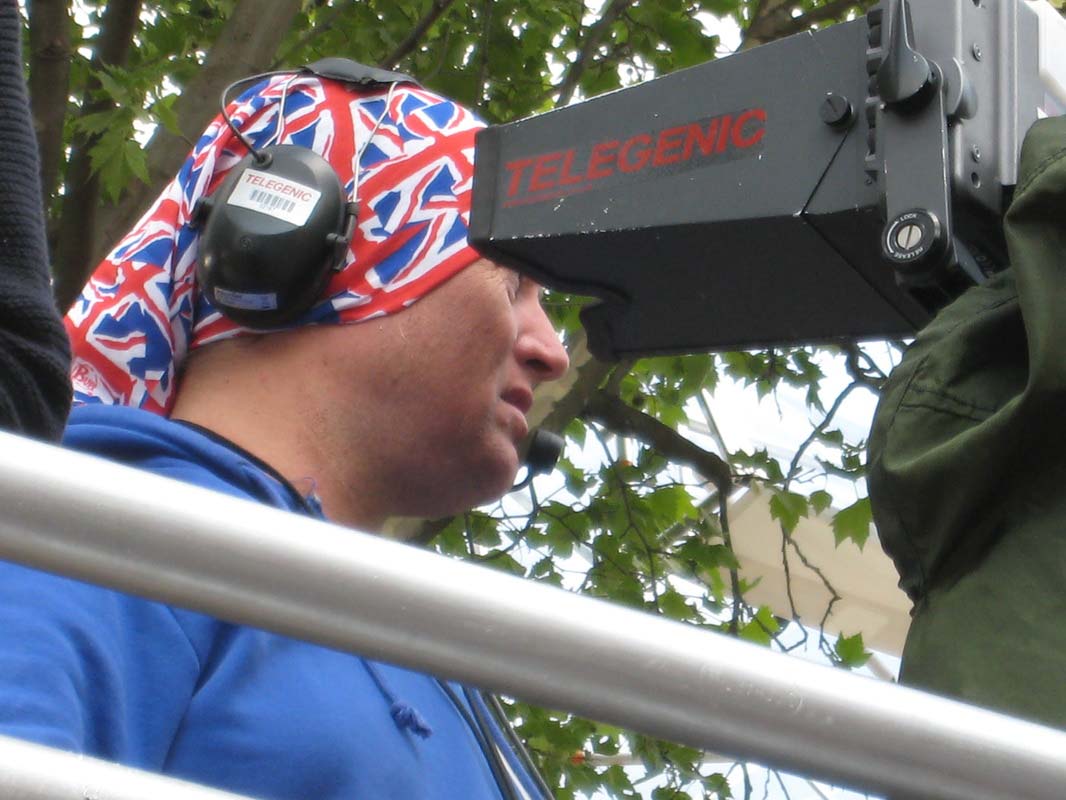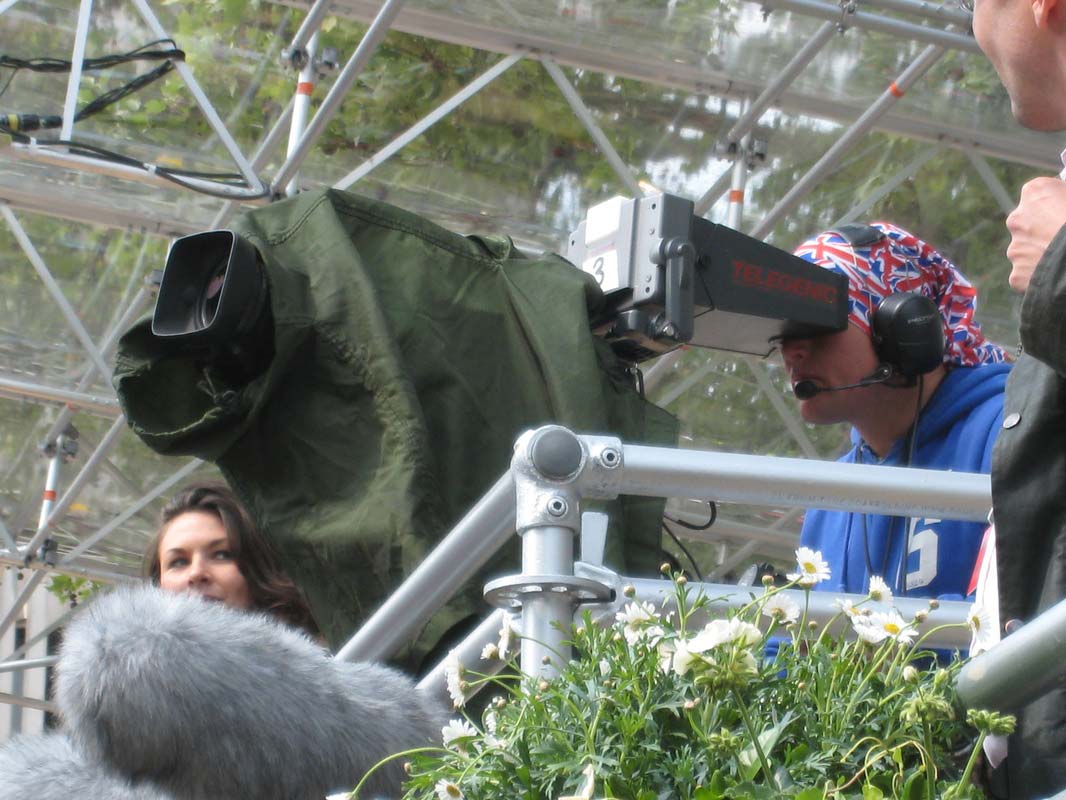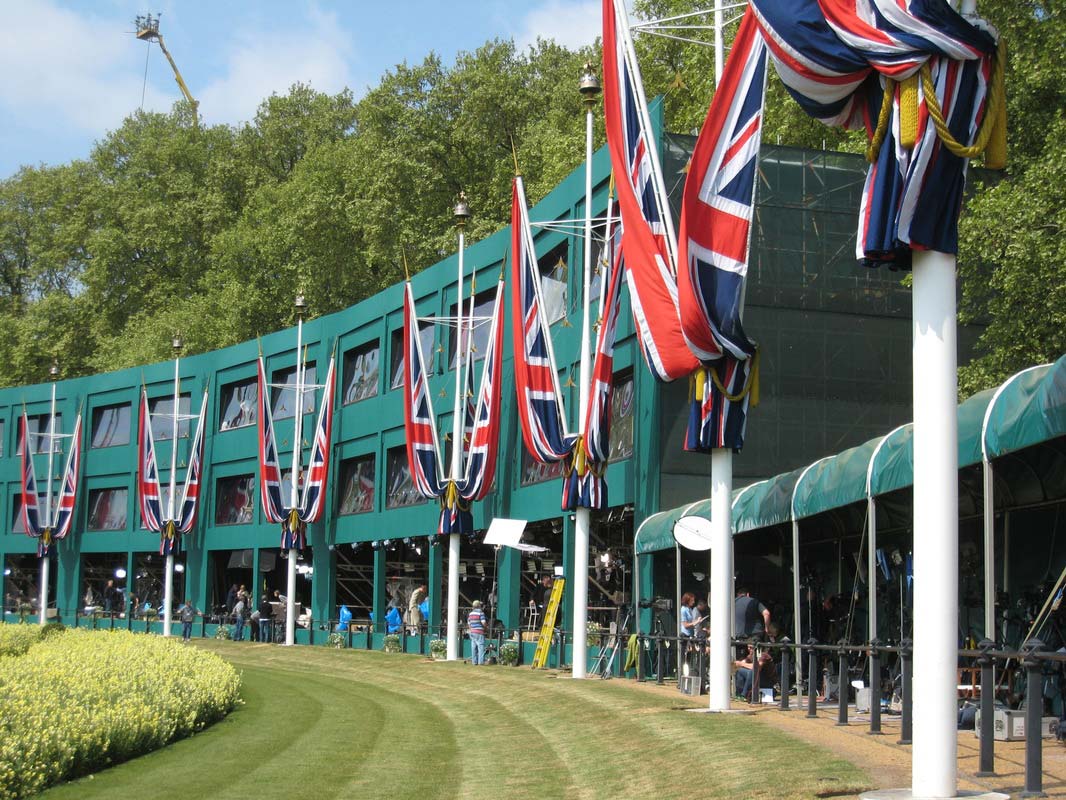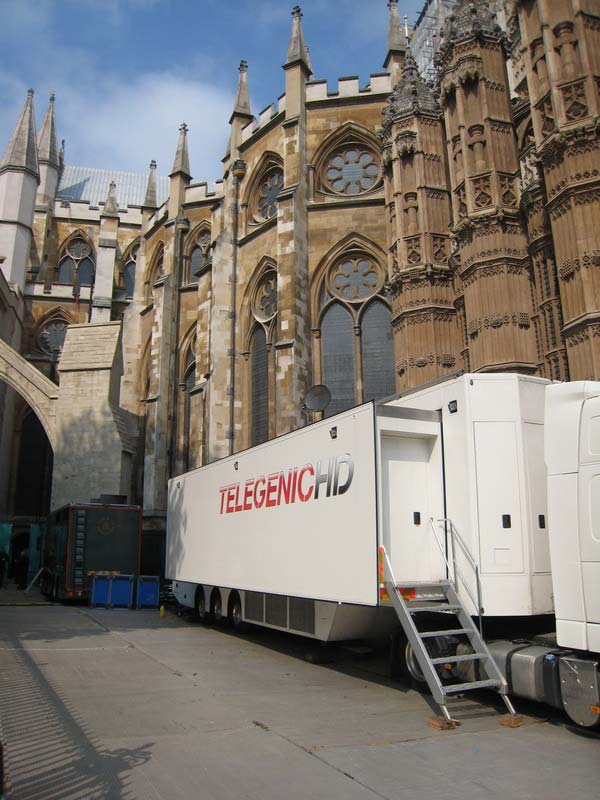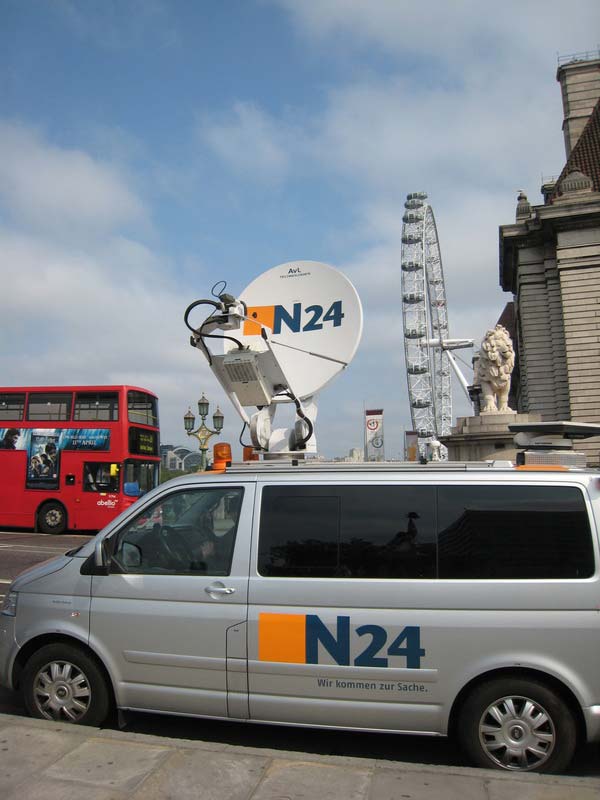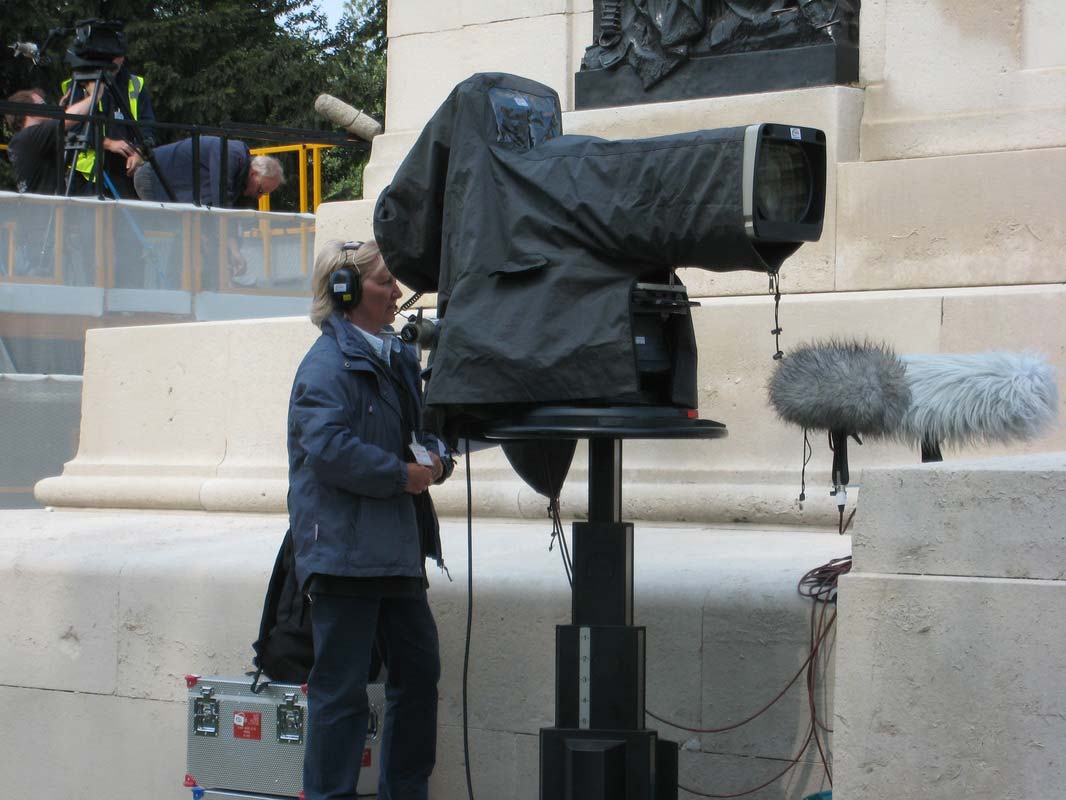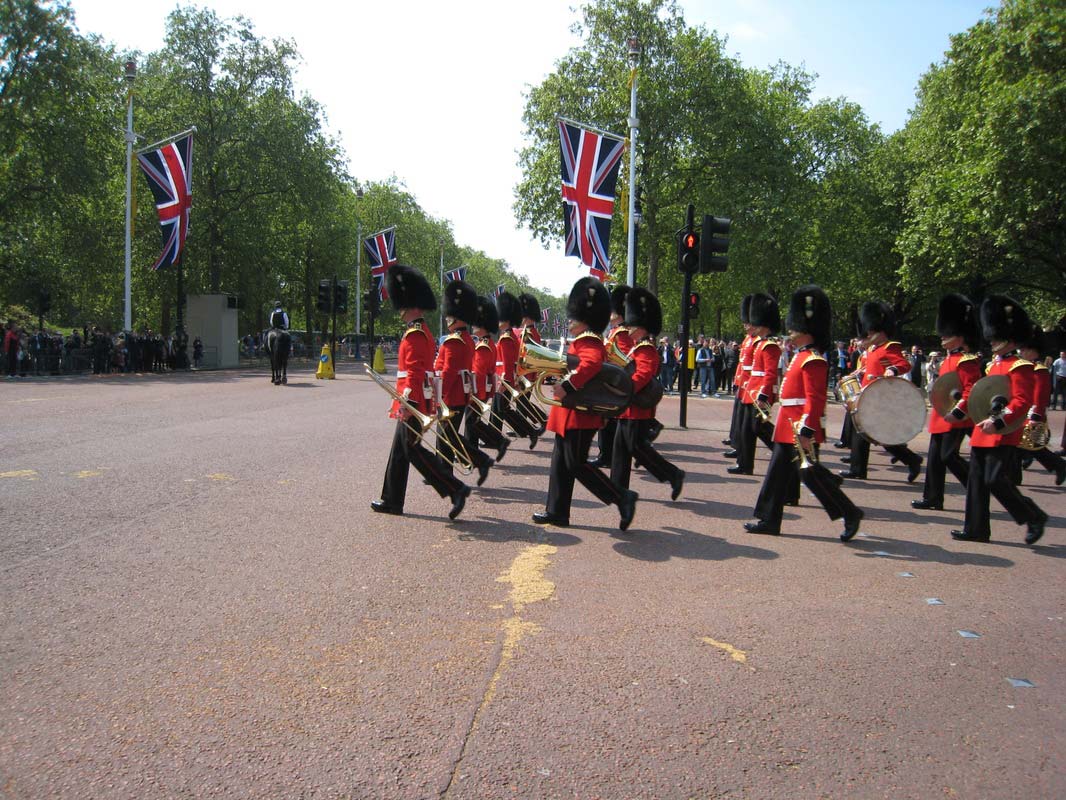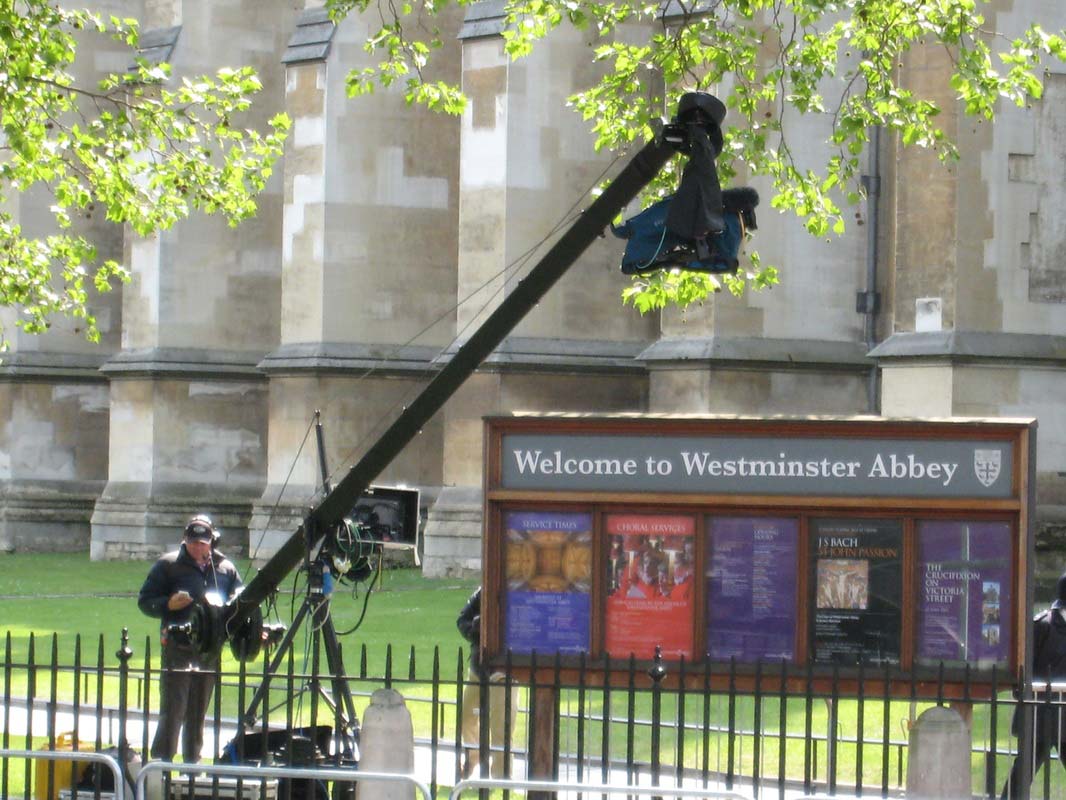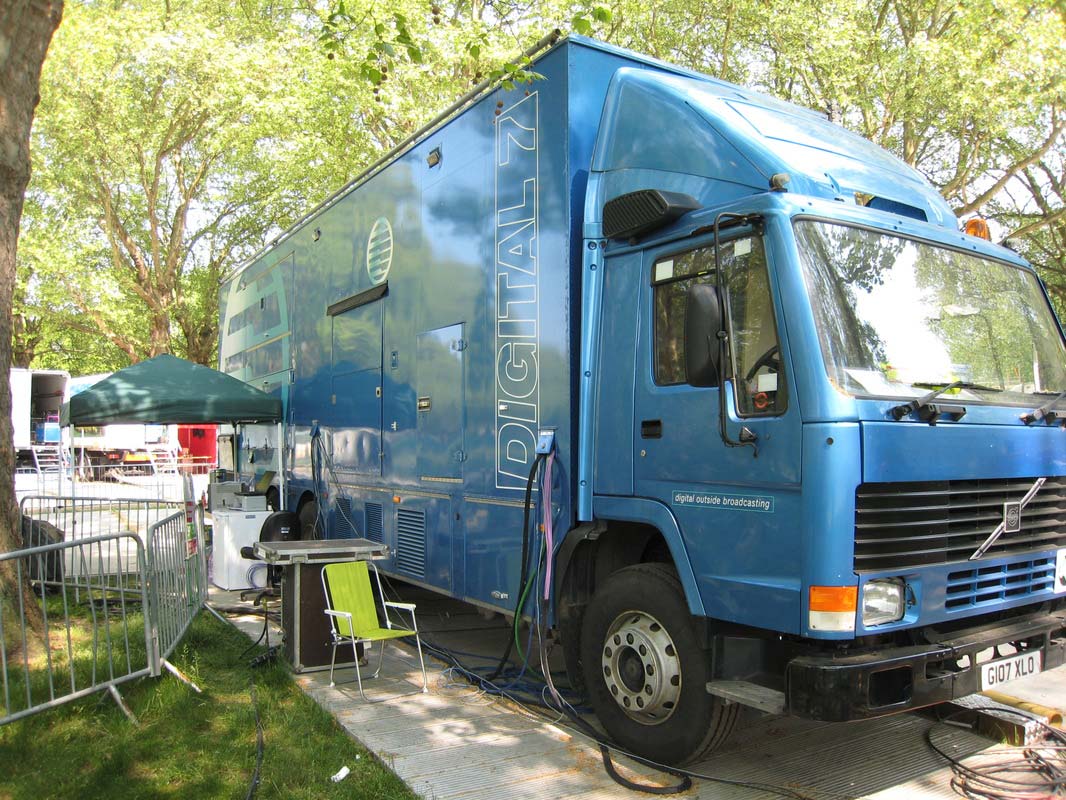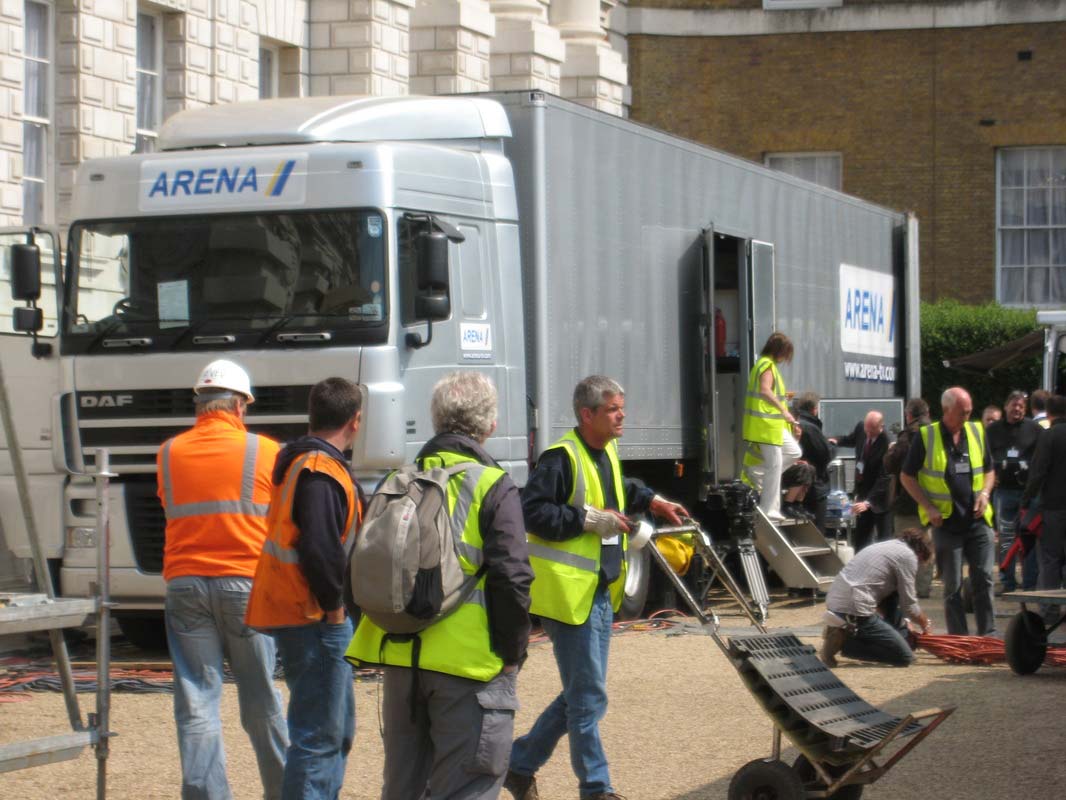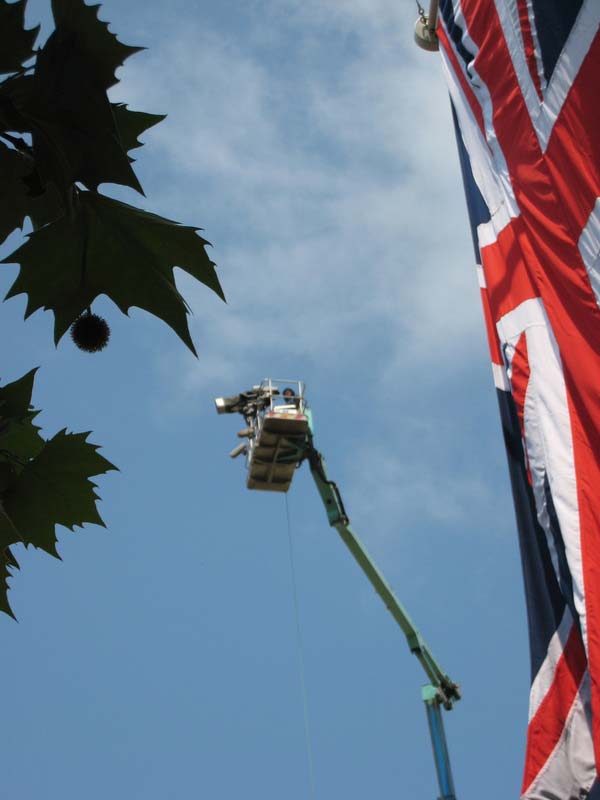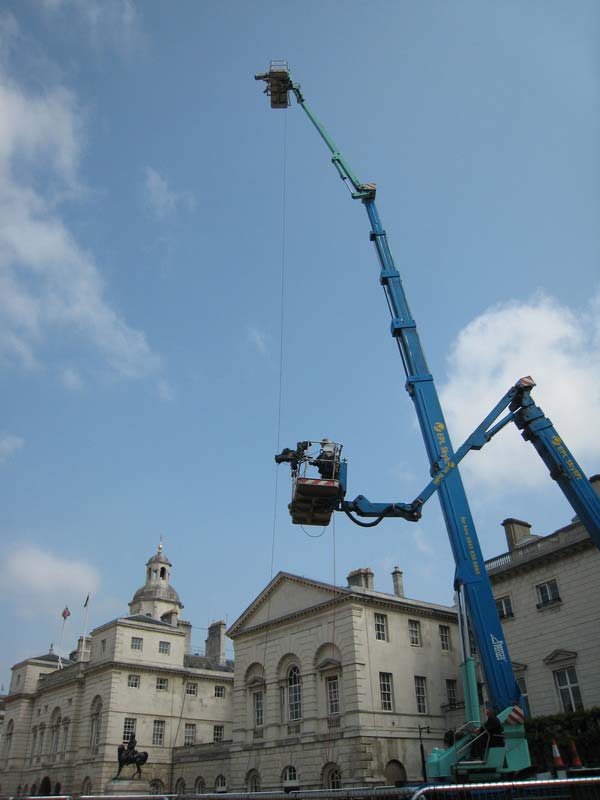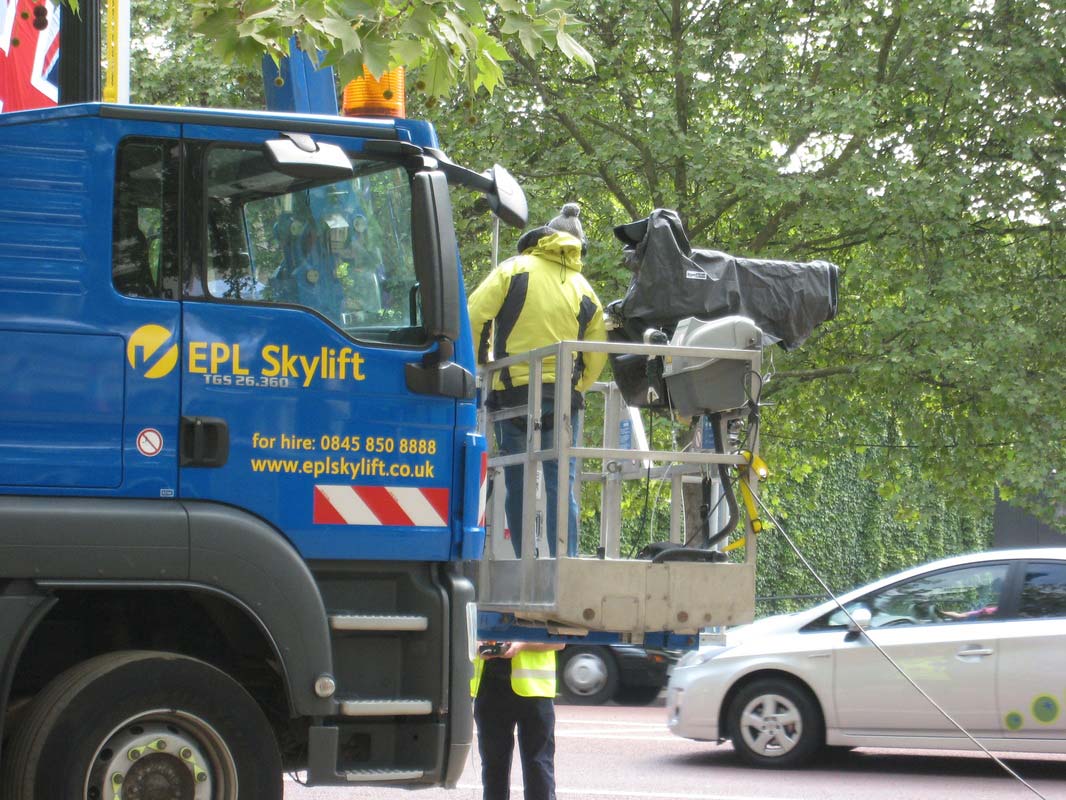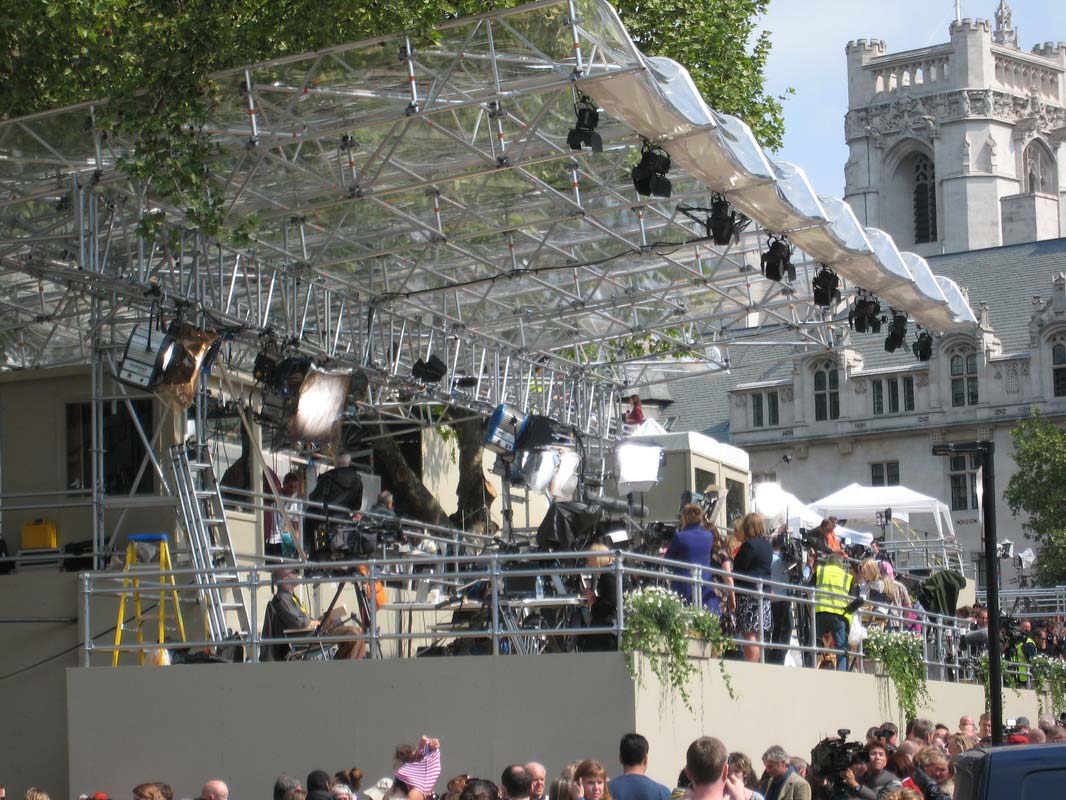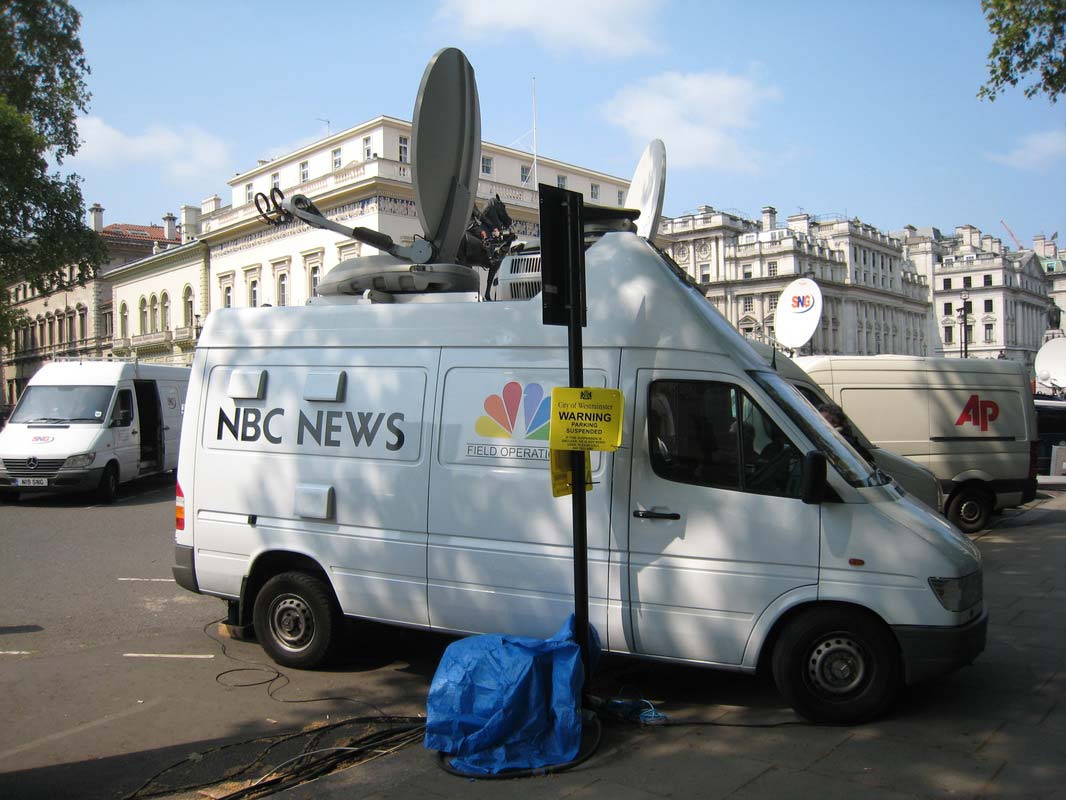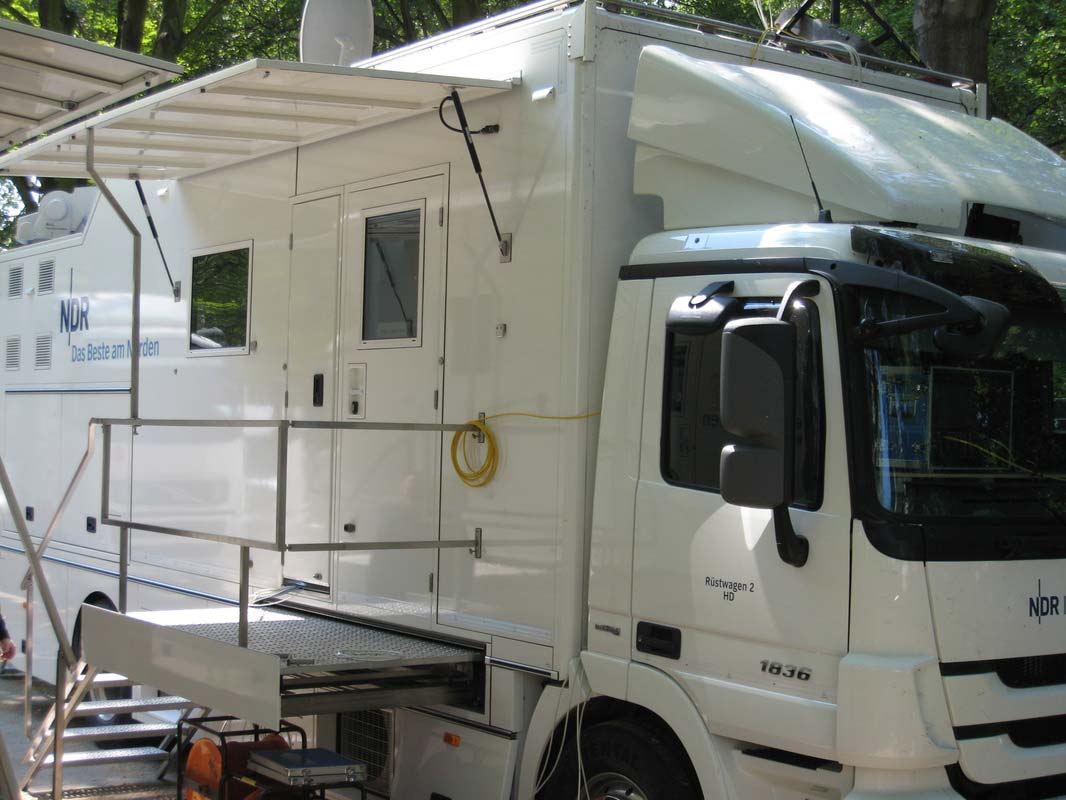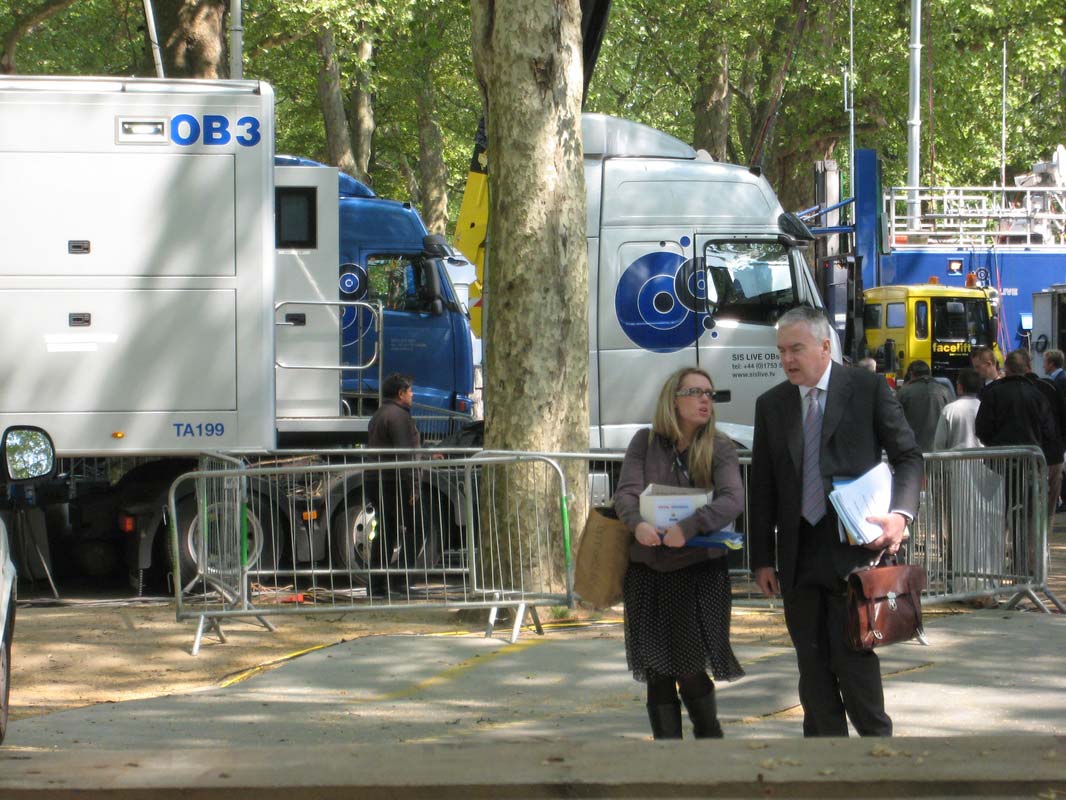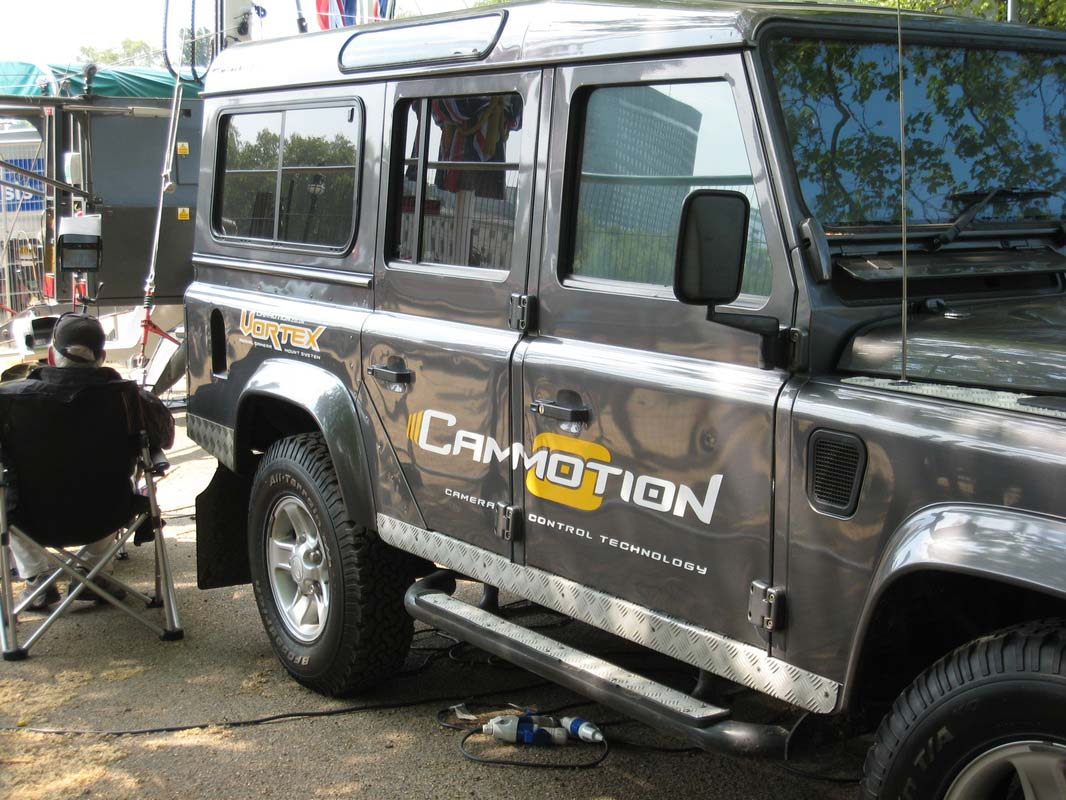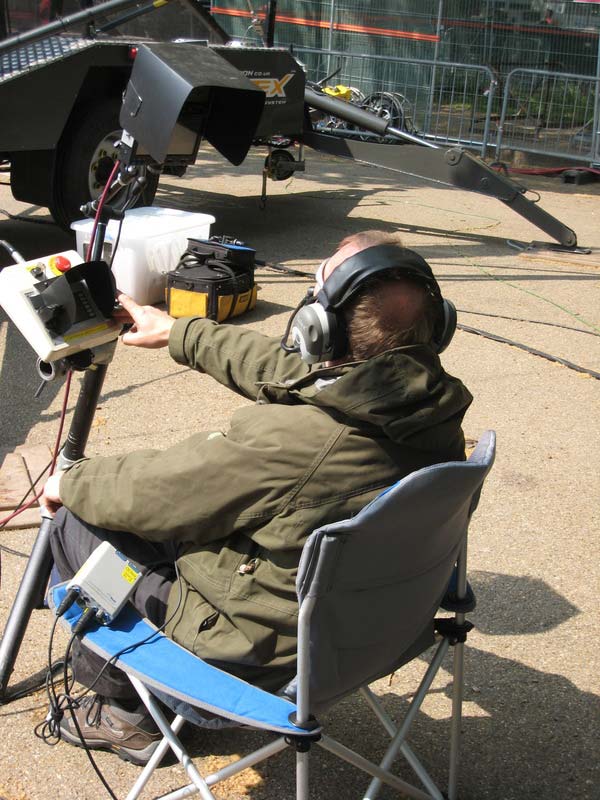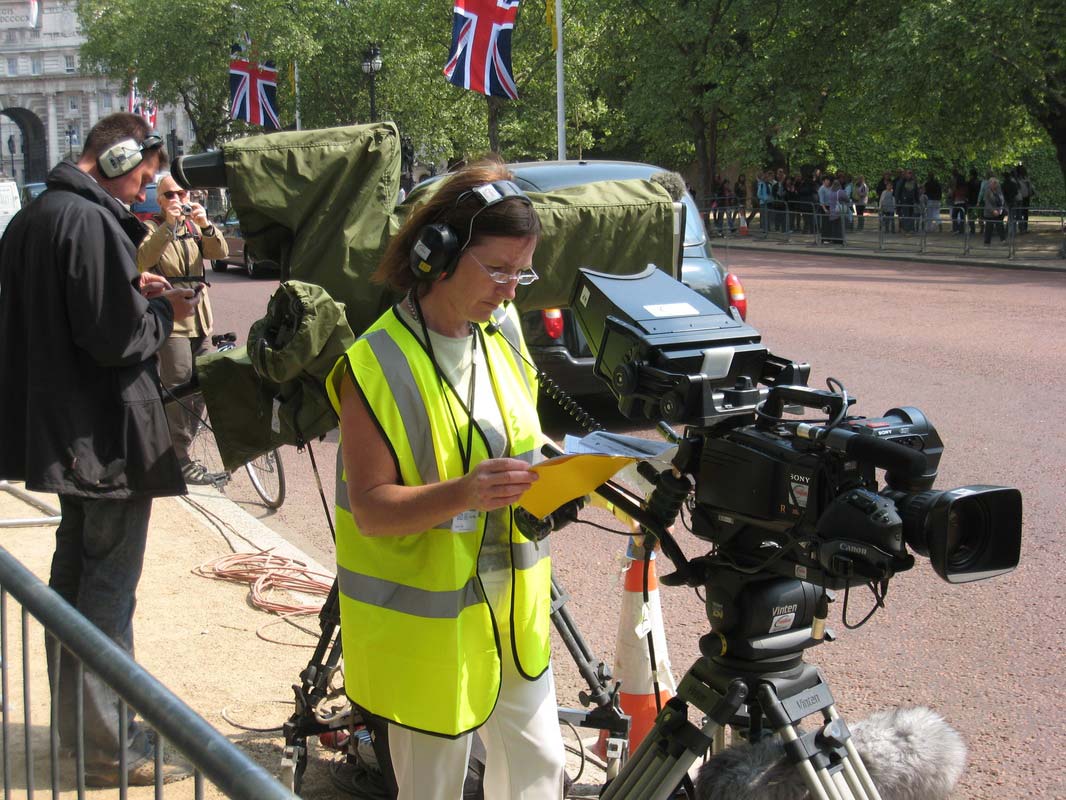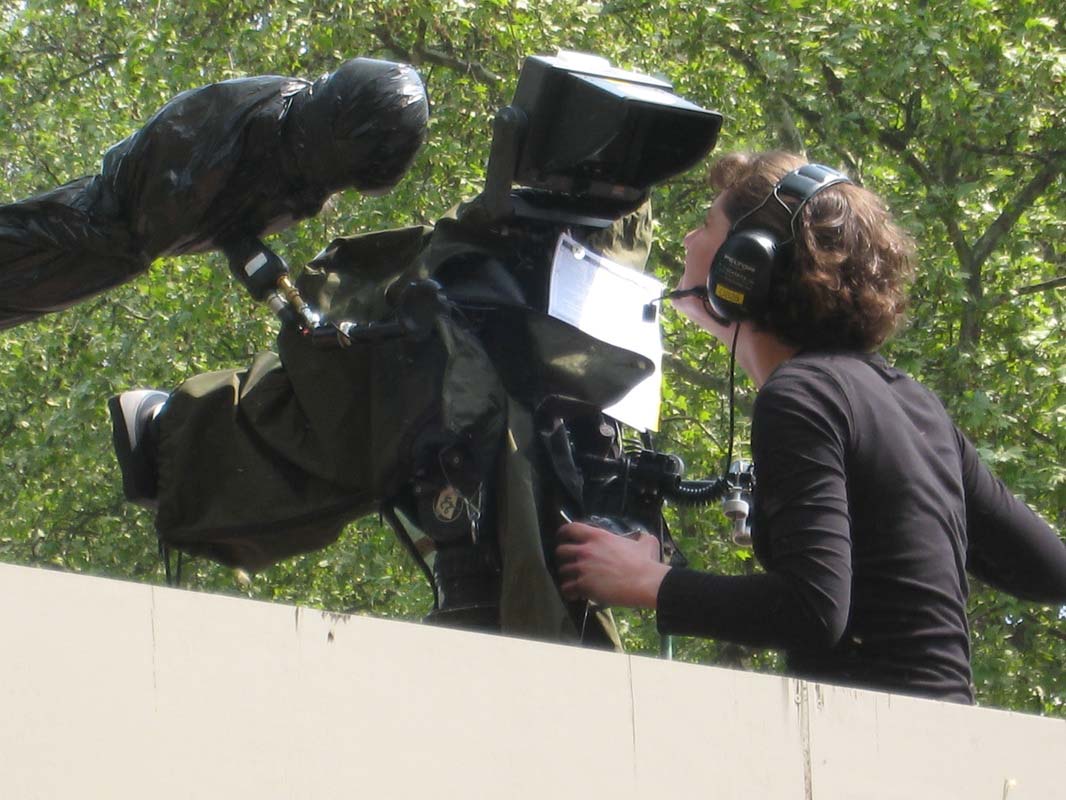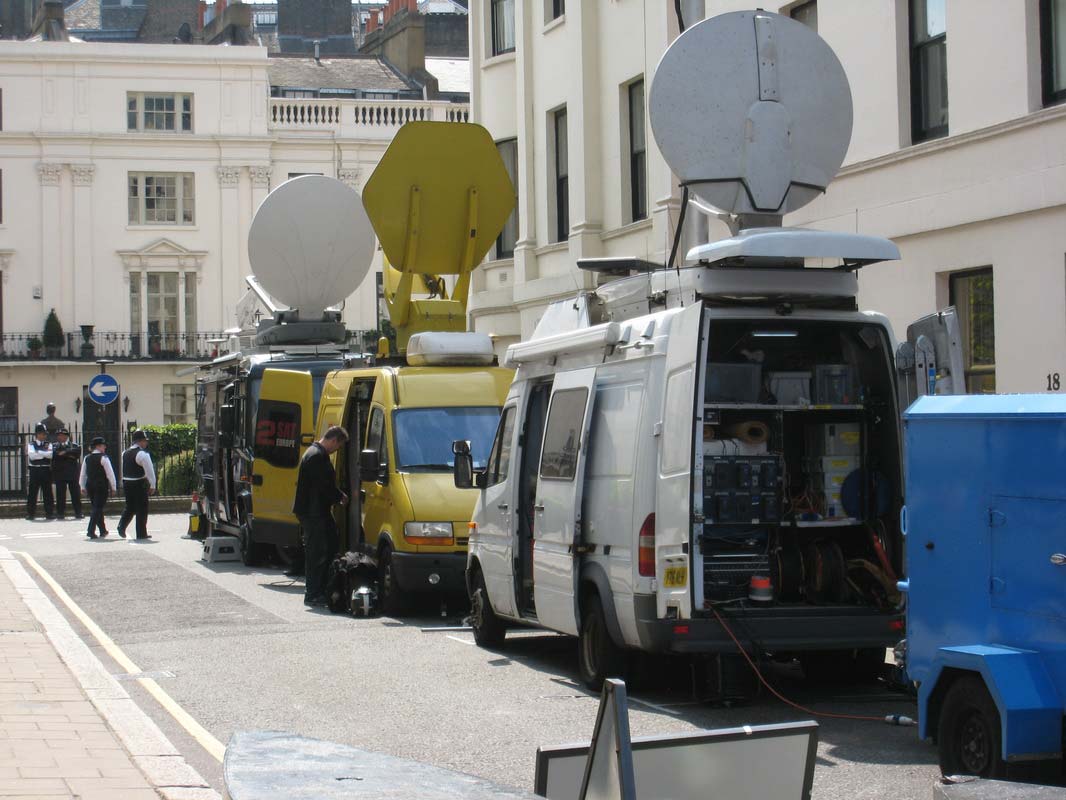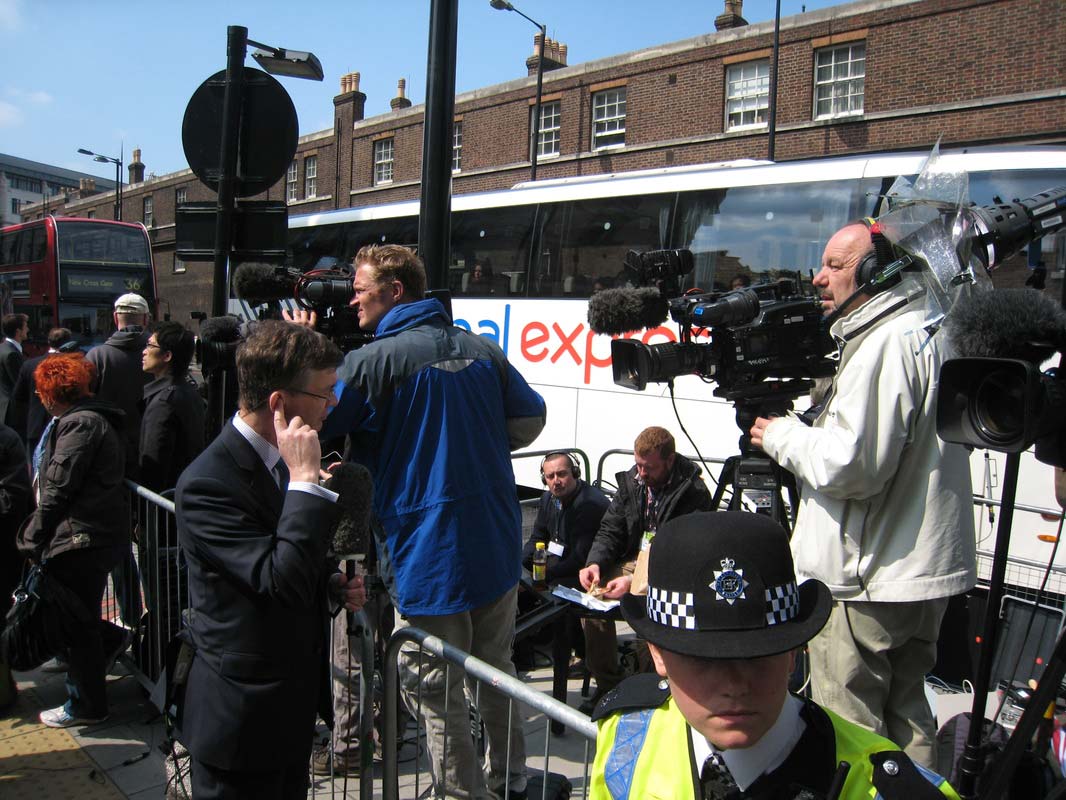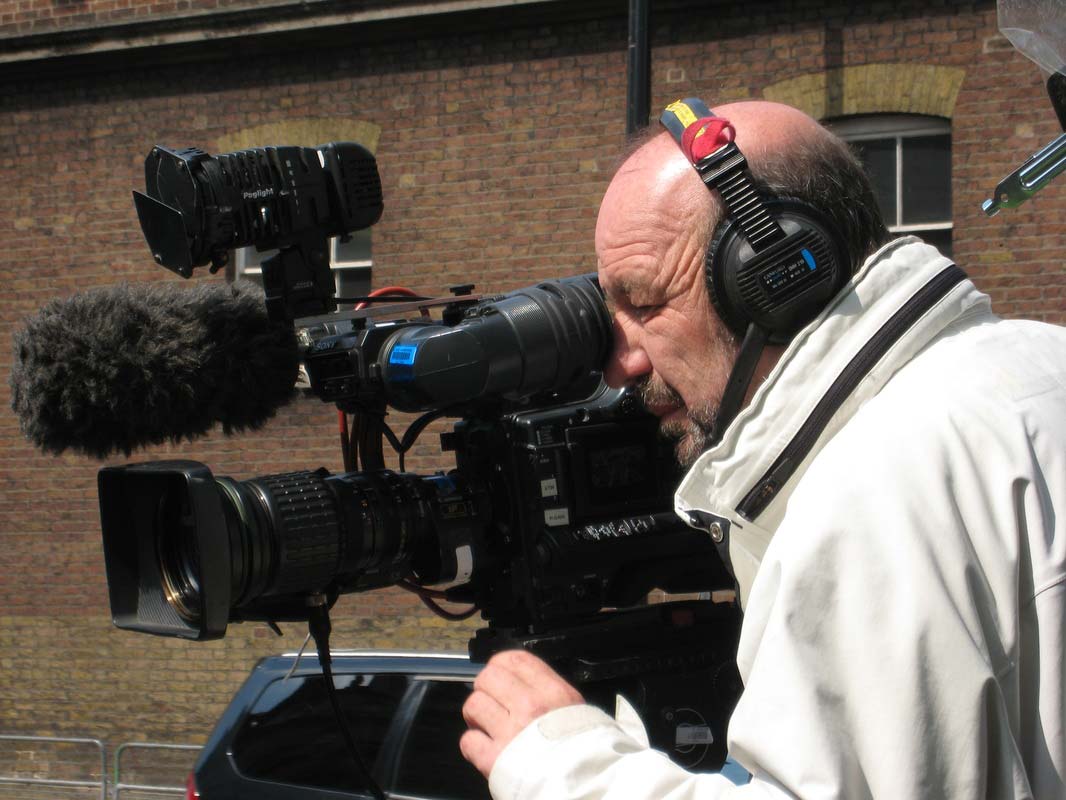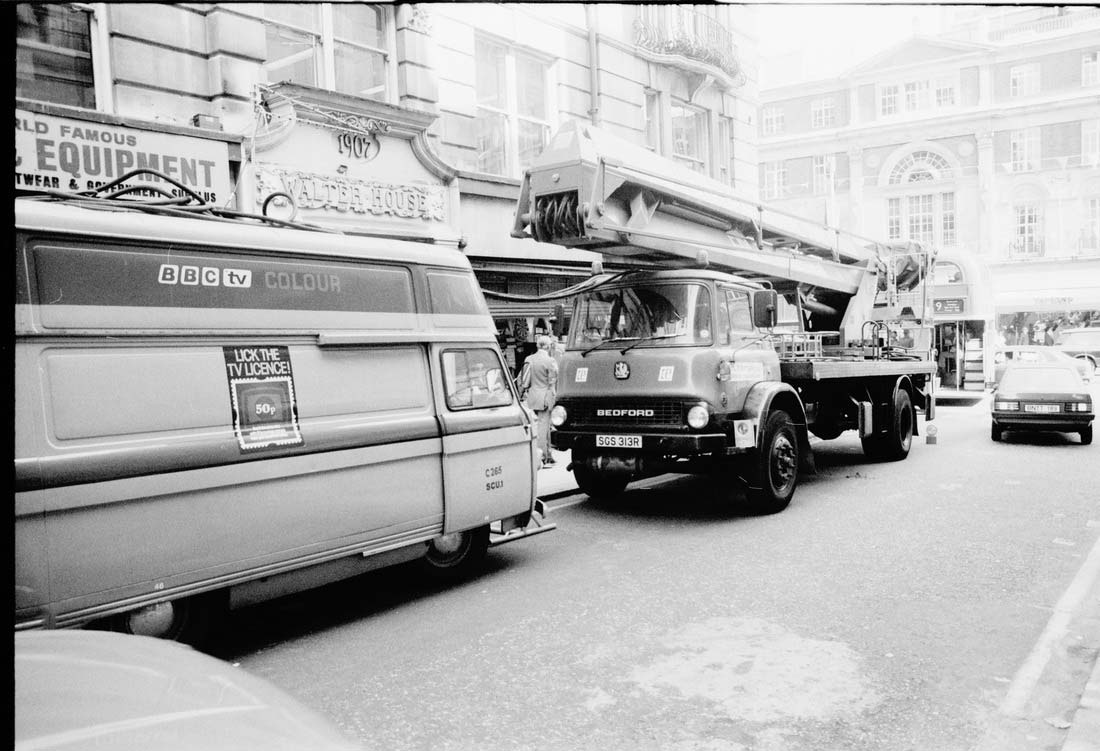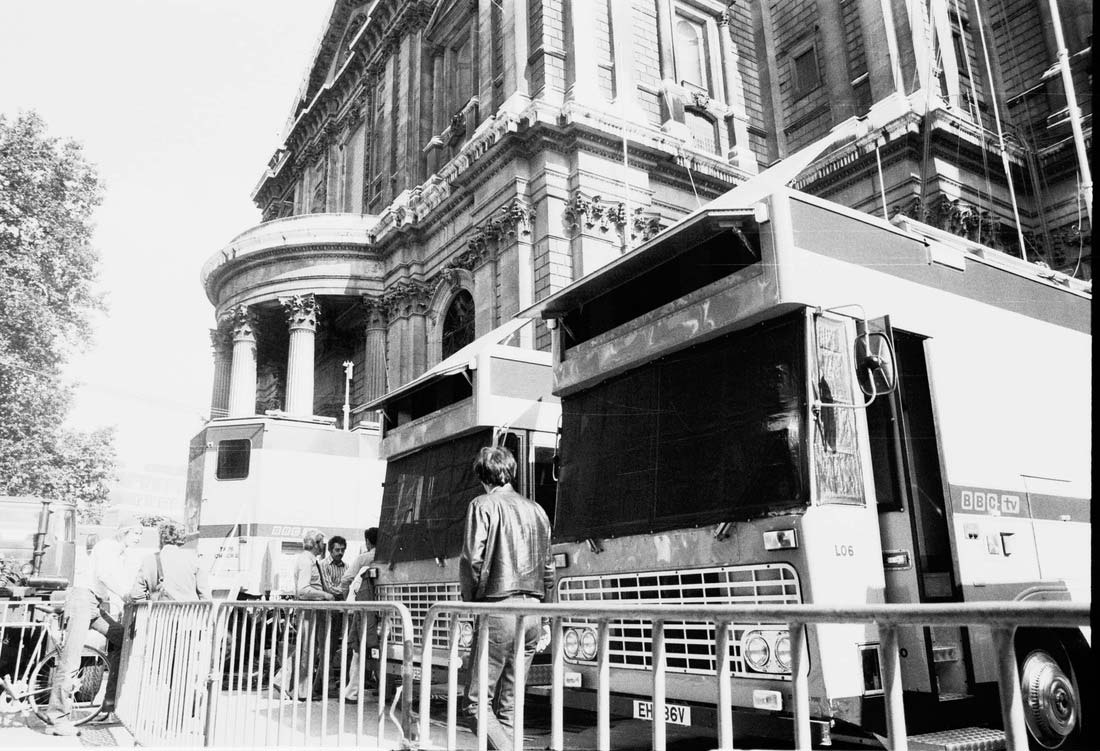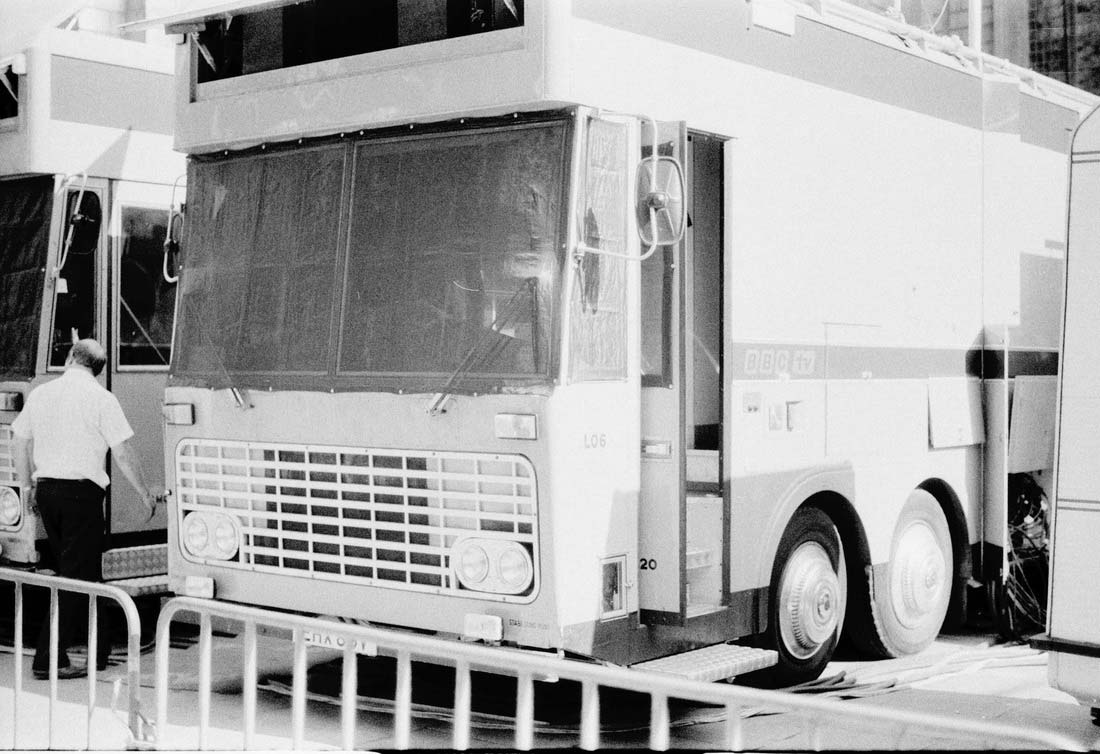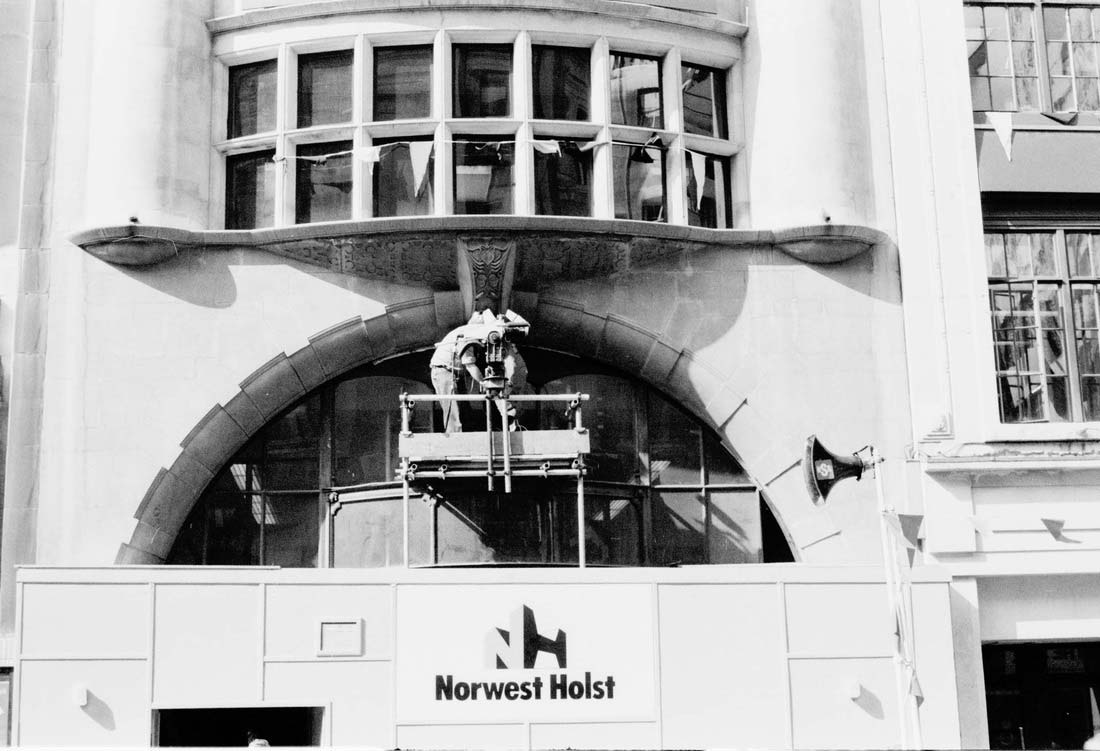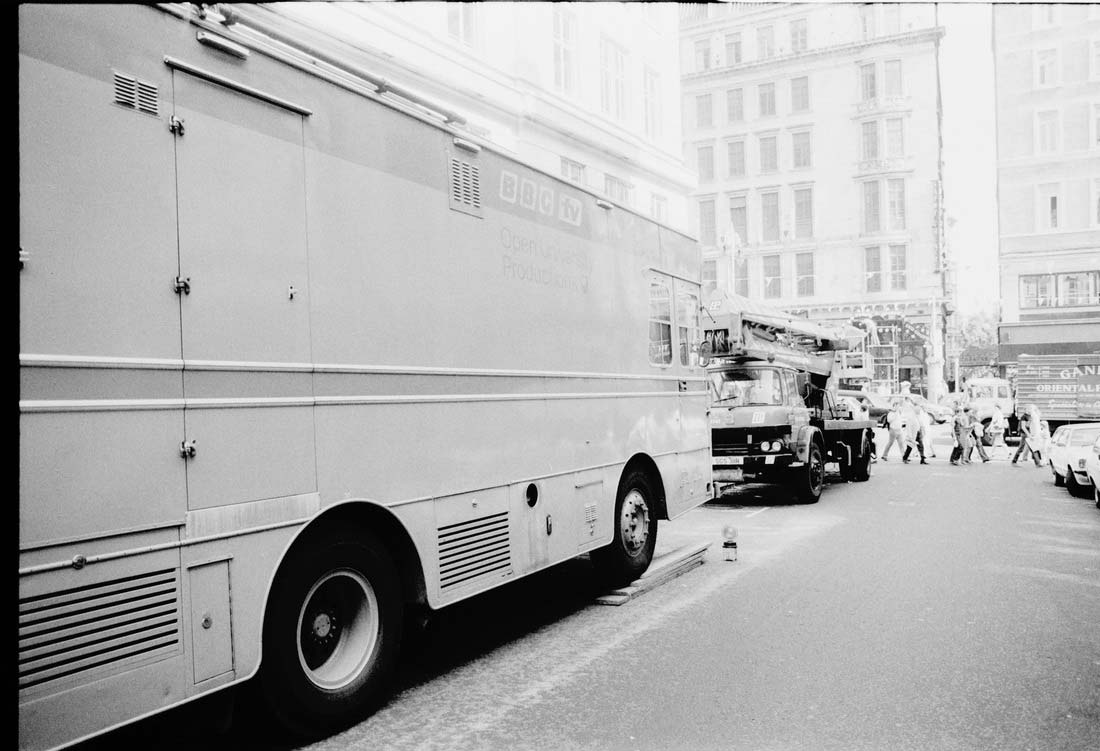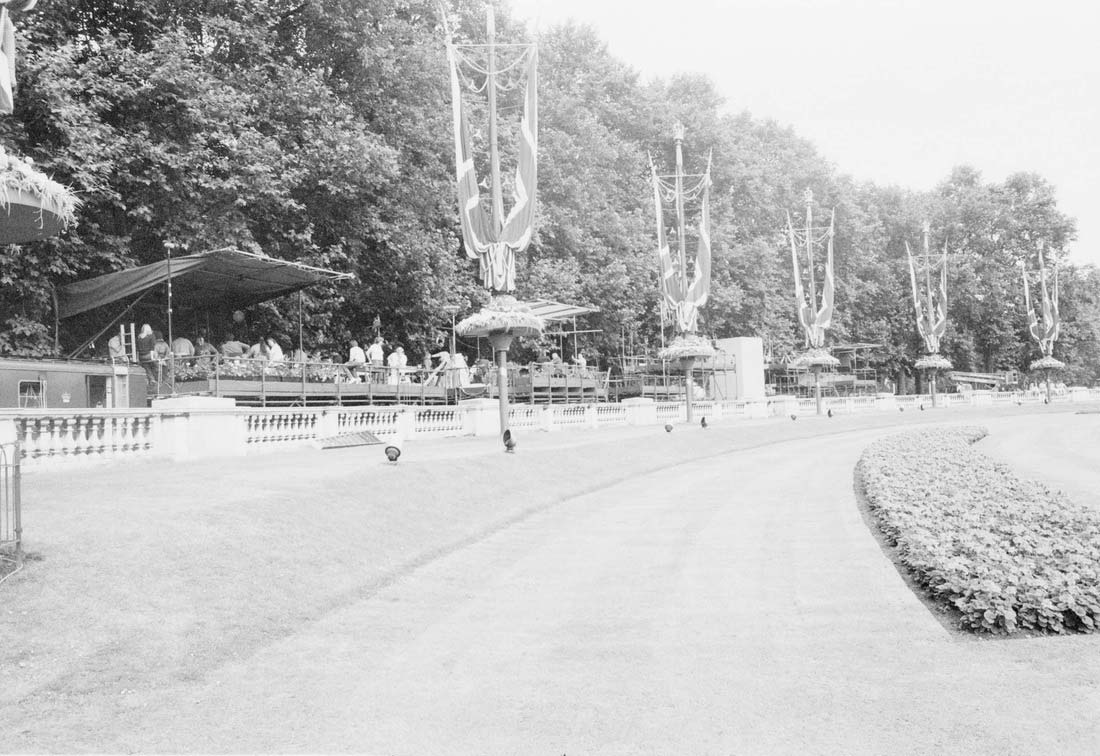The official line was that the Royal Wedding between Prince William and Miss Catherine Middleton was a private wedding, not a state occasion. Therefore you might think that the television coverage would have been a modest affair. In fact there may well have been over a thousand broadcast cameras covering the event; from the small Panasonic DVC P2 camcorder used by the Canadian CBC news crew, to the Sony HDC 1500 and Grass Valley /Thomson cameras used for the live pictures. So for someone who loves television cameras, the atmosphere became quite intoxicating.
In 1965 I was schoolboy living in central London. I remember travelling the route of the Sir Winston Churchill funeral procession. TWW cameras were in Whitehall, Southern Television’s scanner was in Trafalgar Square and Anglia’s two-camera OB was near St Pauls Cathedral. It was like a circus had come to town – something stirred inside me and I knew which career beckoned.
For this much happier event, the Royal Wedding, the BBC was chosen to be Host Broadcaster. That means as well as producing its own programmes, the BBC had to feed pictures of the event continuously to the other domestic broadcasters and to the numerous foreign stations who wanted live pictures. Being Host Broadcaster also meant the BBC had exclusive access to the high altar end of Westminster Abbey where the service was conducted, as there was very limited space for cameras in that part of the Abbey.
So what does it take to televise this event? A lot of planning, according to Christopher Bretnall, technical producer for the BBC. Fifteen OB trucks from SIS, NEP Visions, Arena, Bow Tie and Arqiva had to be linked using fibre under the streets of London. There were three SIS trucks at Canada Gate, near Buckingham Palace. This was the main hub for the BBC, with the studio where Huw Edwards conducted interviews as well as doing the commentary. So one truck was dedicated to the BBC output, taking the camera feeds from the studio at Canada Gate and feeds from all the other trucks hired in by the BBC. Where space dictated at Buckingham Palace and along Buckingham Palace Road, only one camera position was allowed. The positions were divided between the BBC, Sky and ITN, with the BBC taking a ‘tailboard’ feed off each of the other cameras.
The second truck controlled the cameras around the Palace and down the Mall which included a couple of jimmy jibs, a Cammotion Vortex system which soared a camera up to 30 metres at the top of the Mall and a remote camera supplied by Aerial Camera Systems, high on a hoist overlooking the entrance to Buckingham Palace.
The third truck supplied pictures to the other international and domestic broadcasters. The domestic broadcasters received a mixed feed of the event as well as an ISO from inside the Abbey. The foreign broadcasters just received the mixed live feed.
So what else did the BBC need to produce pictures that went right round the world? Another SIS OB truck at Wellington barracks and Bow Tie at Knightsbridge barracks, a NEP truck at Hyde Park where the crowds were having a party watching the big screens, an Arqiva truck in St Andrews where Kate and William met, another Bow Tie truck at Buckleberry, the Middleton’s home village and not forgetting the feed from one of the aircraft in the flypast. Then there were two large trucks from Arena, one covering the procession from the bottom of the Mall through to Horseguard’s Parade and the second along Whitehall with another truck handling the cameras around Westminster Abbey and the second temporary BBC studio built on top of Westminster Central Hall.
The BBC relied on one of NEP Visions trucks to handle the twenty-three cameras in the Abbey. Aerial Camera Systems provided 16 Sony P1 and 4 Ikegami HDL 51 remote cameras. Two of the SMARTheads had Canon HJ 40 lenses. The SMARTheads were fixed into discreet positions using brackets supplied by SIS. The spectacular high shot over the Sacrarium, developing to show the incredible scale of the internal architecture of Westminster Abbey, was achieved using one of ACS cameras. Two cameras were positioned in very sensitive areas to the side of the high altar in order to show the couple from the front during the intimate and important parts of the wedding service. The BBC chose the SMARThead because of its small size, whilst offering 2/3” in full HD and single cable operation
With 26 years of outside broadcasting behind him, Christopher Bretnall has covered many similar large events. So how have things changed?
“ The reliability of equipment is getting better so that we can confidently do things on a bigger scale.” But that certainly hasn’t led to any complacency, as there are many layers of redundancy and resilience built into the system Christopher designed, to make sure there are no breaks in transmission. How did things go on the wedding day? “ You can imagine that there are a myriad of problems that need to be solved on the day, logistically or with crews, with equipment or with events changing, but I don’t think that any of it was reflected in what was seen on our screens.”
In 1981 Prince William’s parents married in St Paul’s Cathedral. It was then the biggest colour outside broadcast the BBC had undertaken. The Corporation managed to muster 17 scanners with a little help from TVR and Trilion. At St Pauls there were 18 cameras covering the service inside as well as the exterior shots around the Cathedral. Supporting the BBC’s Central Control room, equipped with 42 B &W monitors, were two BBC Type 5 scanners each with eight cameras and another two-camera unit. In total the BBC used over sixty cameras. Thirty years later, the BBC, despite selling off its own trucks, would have no trouble finding double that number of HD colour cameras from the numerous facilities companies.
The BBC lighting director, responsible for lighting St Pauls for Prince Charles and Diana’s wedding, Bryan Wilkes, took advantage of the then new Compact Source Iodide lamps because of the high light output per kilowatt. He had to use 275 1 kw units and other lighting units weighing in total 17 tons to bring the light up to an acceptable level for the Philips LDK 5 cameras.
Bernie Davis was the BBC’s lighting director for Prince William and Kate’s wedding ceremony. So was Bernie happy when it was announced that the service was going to be at Westminster Abbey and not St Pauls? “Both places have their problems. St Pauls is easier to light than Westminster Abbey. The Abbey does set come challenges for where we can put lights. St Pauls is a much more open space, it is a much more straightforward one to light. The biggest problem in the Abbey is that around the choir area and the high altar, the triforium, which is the natural place to put lights, is quite high and limited in space. You can only get a small amount of lighting in one of the windows of the triforium. Also it is a very steep angle for getting faces looking good. So in the Abbey we have another position at a lower level. There are tie bars in the arches below the triforium where we put our scaffolding that we put lights on.”
So how do you light such a large area with all the restrictions about where you can position lamps? Bernie chose to use 350 PAR cans, most with ¼ blue gels “It surprises people that I use PAR cans but if you look at discharge lamps and big Fresnels they are big lumps of kit with big barn doors, while PAR cans appear as nice little rows of circles of light. Now I know you don’t get the shaping but if you have got relatively narrow beams, point them where you want to and if you have got six par cans to cover an area you can spread them in a way that you want. With the PAR cans you can choose the bulb you want (narrow, medium or wide beam). The bulb is the light source, the reflector and the lens all combined, so every time the bulb goes it is a new reflector and a new lens, which means it, is always working at its optimum. With 1Kw I could carry four of them upstairs comfortably, whereas something like a 5kw Fresnel, it would be as much as I would want to lift it let alone carry it upstairs. So the PAR cans are easier to mount, they look tidier when they are up there and they plug up very neatly into dimmers.”
Bernie uses a Compulite Vector Violet desk. ”What I like to have is control over the lighting sources, and although you can get dimmer shutters for discharge sources, they are an added complication and expense. What I like about tungsten light is that it has got a very good colour rendition. It is very nice for faces. Discharge lighting is OK, but it’s never as flattering and friendly as tungsten.”
In 1981 Bryan Wilkes had 0.6 ND CTO gel on the windows of St Pauls. Bernie “ I am not sure if I would be allowed to gel up the windows these days at St Pauls, because it looks ugly from the outside. What I like to consider when I am lighting anything of this nature is; this is somebody’s event, somebody’s wedding and whatever I do has to be good for them. It is not a TV studio, so I will compromise the look, to a certain extent,
in order to make it good for them. I have experimented and learnt a lot from both St Pauls and Westminster Abbey and I know how to get the lighting comfortable but good for the cameras. If you look at the wide shot inside the Abbey, the top of the picture is quite blue in comparison with the bottom. I like that. The RAF fanfare, if you look at that, they have got a nice cool backlight, well that is daylight. You have to think where the shots are and work with it. I think that it looks good to mix colour temperature in a controlled way. Bryan Wilkes did just a fantastic job, especially considering they had tube cameras. I was rather lucky that my lighting career started in television just when chip cameras came in, as it was so much easier to make good pictures. They handle contrast better. You couldn’t pan across a window with daylight outside with tube cameras, it would just smear everywhere. Whereas now, even if it burns out, it’s acceptable.”
“The advantage today is that is that cameras are much more sensitive these days. Bryan Wilkes was lighting to a level of 1700 lux. Well thank goodness I didn’t have to light to that level. I didn’t actually measure the level but I know the level, the emission I get out of the Pars and I guess from the exposure, I was probably lighting to about 500 to 600 lux. It means the cameras were working at an aperture of about F4. It’s comfortable for the cameras and it gives a certain amount of focal separation without making it a struggle for the cameramen. The other thing is we have to work with daylight and if I lit too low the daylight would take over”
Bernie did use some other lights. There were a few profiles for picking up pulpits and reading positions just to highlight the people a bit more in the direction he wanted; four small Fresnels lighting under the organ loft; two 575 MSR lamps lighting the bells and five LED PAR cans up-lighting the arches behind the high altar. LED lights were used as they do not give off heat and they were positioned in a very ancient part of the Abbey. Bernie decided to keep the existing chandelier lights on but at a low level. He also used four of the existing profiles. “I was watching to see if they were a problem and they weren’t. The only thing that was slightly odd were that the ones on the Tomb of the Unknown Warrior were very hard focus, which looks good by eye but by camera, if anybody passed near it, you saw this hard line of light which I didn’t like. So we just put a Hamburg Frost in the profiles that lit the Tomb. It kept it focused but with a softer edge.”
While the BBC was the host broadcaster, ITN provided coverage for ITV and Sky. Apart from using the BBC feed from the cameras around the high altar in Westminster Abbey, ITN covered the event with OB trucks supplied by Telegenic at the Abbey with CTV trucks along Whitehall, Horse Guards Parade, around Buckingham Palace and the Mall as well as at Wellington Barracks and Hyde Park. ITN did upstage the BBC in one area. At Wellington Barracks looking across to Buckingham Palace and St James Park, ITN had a hoist from EPL Skylifts, which took a camera and cameraman up to 100 metres, twice the height of any the BBC used.
Many of the US and European networks took studios next to the BBC, ITV and Sky, housed in the temporary three-storey building next to Canada Gate. Either side of the Mall, facing the Palace, were twenty-two single storey tented camera positions. Steve Acton was one of the cameramen working for Eurovision, which occupied twelve of the positions. “Most of the left hand side was ours and we had half the other side. We had a nice backdrop of Buckingham Palace and every fifteen to twenty minutes or so a broadcaster from say Poland would come and stand in front of the camera and do a little piece to camera. Next to us was CNN. An American reporter had thirty microphone idents for different US TV stations in front of her on the floor. Every time she did a ‘stand up’ she pulled off one and put on a different one and would do exactly the same report for that station. It was really funny to watch.”
Around 750 million people watched Prince Charles and Diana’s wedding. Thirty years later the BBC, with two billion people watching, again produced a near faultless live production. Sadly there were no BBC television OB trucks but most of the key roles, on the facilities side, were undertaken by ex BBC staff.
Christopher Bretnall
After 19 years at BBC Outside Broadcasts, culminating as
Head of Project and Engineering Management, Christopher set up Creative Broadcast Solutions to continue to deliver technical broadcast productions to a wide range of international clients. This has included such diverse projects (as Head of Broadcast) as “Live 8”, “Live from Abbey Road”, “Miss World” 2005-2008, London Fashion Week, and the Rolling Stones in Twickenham.
Bernie Davis
Bernie Davis has been lighting television programmes since 1987 and in that time has worked on a great range of styles from the smallest to the largest of productions including Carols from Kings and The Proms. Before that Bernie worked as a vision engineer with BBC Outside Broadcasts and so has a very thorough grounding in all aspects of TV cameras and production techniques. He has won three Royal Television Awards and four Bafta Cymru awards as well as receiving many nominations.
